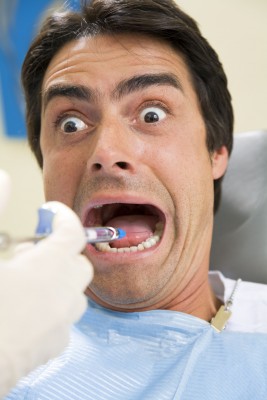
Dentist ≠ Pain
Many people associate a trip to the dentist with pain and they continue to do so without realising that nowadays there is no pain. With the advancement in dental diagnostic and therapeutic techniques, dental procedures now can be performed with precision, much faster and with minimal downtime for the patient.
Dentistry has evolved to a point where pain is no longer a factor in the overall management equation. With trouble free post-treatment recovery possible, patients no longer have lingering “bad” memories or experiences at their dentists’ office.
Why Pain Arises
Dental pain is one of the most intolerable body pains one can withstand. It has been said that dental pain from a broken tooth can bring the bravest of men to his knees.
-
Lack of good oral hygiene contributes to development of gum diseases and dental cavities.
-
Lack of good oral health education and dental awareness also deters patients from regular visit to their dentists. The dental problems then snowballs to bigger and more severe ones as time goes by.
By visiting the dentist on a regular basis, problems can be spotted early and resolved before any pain or infection occurs.
Dealing with Anxiety
Possible reasons for anxiety:
-
Extreme anxiety in dental patients can often be passed on by their family or friends. Not everyone enjoys visiting the dentist; some may even have very bad previous experiences before.
-
Sometimes dental anxieties may be a result of stereotypical portrayals from popular culture.
-
Clinical atmosphere. The saying goes: “Appearance matters”. Well in relation to managing our patients’ anxiety, this holds true. “Clinical” looking dental offices that emit the classical smell of disinfectant and the sound of the whining dental drill can also contribute to the anxiety factor in patients.
Allaying Anxiety
-
Pleasant ambiance at the clinic. Dental clinics these days are decked out in warm interior décor together with comforting lighting while disinfectants are now odour-free. Television and music are available to entertain patients in the waiting room and in the treatment room.
-
Good communication between dentist/dental team and patient is critical. Speak with your dentist regarding your oral health and let him or her know if you are anxious about the dental appointment and the treatment. By understanding and knowing more about the procedure, you will be in a better position to control your anxiety levels because you know what to expect.
-
Access to Information. More information about the qualifications, experience, track record of your dentist and the procedure itself prior to treatment will also reduce anxiety as you would have a higher level of confidence in the dentist and would know that you are in good hands.
-
Anti-anxiety oral medications can be prescribed prior to a dental visit to reduce anxiety levels; this will lead to a faster and smoother delivery of treatment thus making the entire dental visit more pleasant and acceptable.
Studies have shown that pain is more often experienced when people are anxious, anticipating the “worst”. With the fear of a stereotypical dental office setting removed and better communication and trust between the patient and the dentist, patients are in a better position to experience dental treatment without any pain.
Relief from Pain
Most dental treatment can be delivered with or without local anaesthesia. If the procedure is simple, local anaesthesia may not be needed. No one enjoys the sight of a needle or being pricked by one. Generally, if your dentist makes you feel secure and you feel comfortable in the soothing surroundings, a simple cleaning or filling can be performed without the need for injections.
Local anaesthesia is required for dental procedures such as deep cleaning, deep cavities, root canal treatment and many cosmetic procedures (crowns, veneers, etc.) Anaesthesia is also required for outpatient/ in-office oral surgical procedures such as simple and complex dental extractions, wisdom teeth removal, oral biopsies, gum surgery, dental implant placement, bone grafting etc. With topical or surface anaesthesia applied first to the area, dental injections when delivered in a controlled and slow pace, can be with minimal or no discomfort at all.
Patients may also opt for in-office intravenous sedation, delivered by a team of well trained and qualified specialist anaesthetists. During the sedation procedure, vital parameters such as blood pressure, pulse rate and oxygen saturation levels are constantly monitored throughout the entire dental procedure to ensure the safety of the patient. Sedation is suitable for patients aged 7 years old and upwards.
Patients may also opt for general anaesthesia which is a very deep level of sedation requiring airway maintenance and breathing support with the anaesthetic machine. Hospitalisation may or may not be required; but a proper operating theatre facility and set-up is required, thus raising the total cost of treatment.
Patients may want to opt for in-office sedation as the best alternative.
Relief from Financial Pain
Besides dental pain, patients may also feel financial pain from undergoing dental treatment.
-
“Prevention is better than cure”. Regular visits to your dentist are important to spot problems early. A small cavity is easy and more economical to treat than a huge and deep cavity that may require extensive treatment like root canal therapy and a crown.
-
Speak with your dentist regarding treatment fees and payment methods to avoid any surprises. Certain dental surgical procedures are also covered by Medisave or certain insurance schemes. In addition, some clinics also have interest-free instalment plans available or are registered for the Baby Bonus Scheme which would aid in providing some relief from financial pain.
Your Dentist – Your Partner in Health

Dental treatment or procedures do not need to affect your lifestyle or work routine/ schedule. Pain is no longer in the equation with proper diagnosis, management and delivery of treatment. Certain implant procedures are now minimally invasive (keyhole) in nature. Oral surgery performed together with intravenous sedation offers minimal downtime for recovery and patients are back to their normal routine within 1 or 2 days.
Advances in dental diagnostics and treatment coupled with highly trained and qualified dental health professionals can bring dentistry to the next higher level: Pain-Free Dentistry.
Remember your dentist is there to take away your pain; start treating your dentist as your partner in oral health preservation and smile transformation and you will begin to feel less anxious about your whole dental visit.





